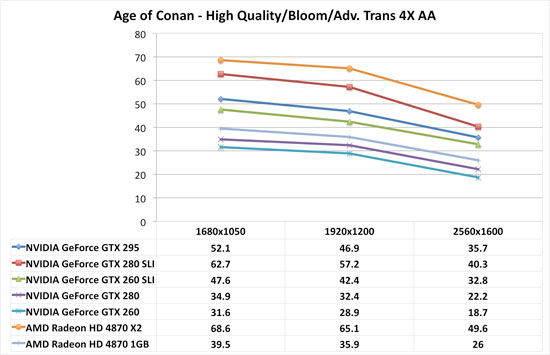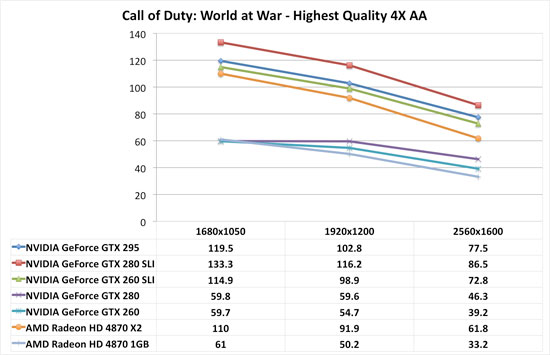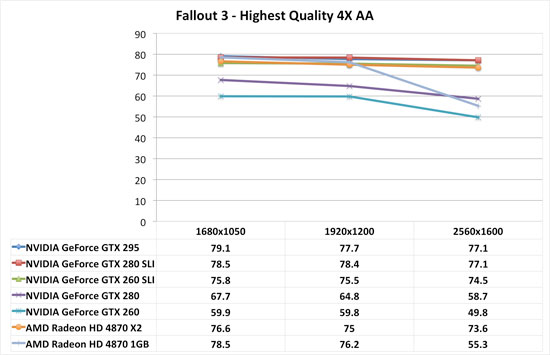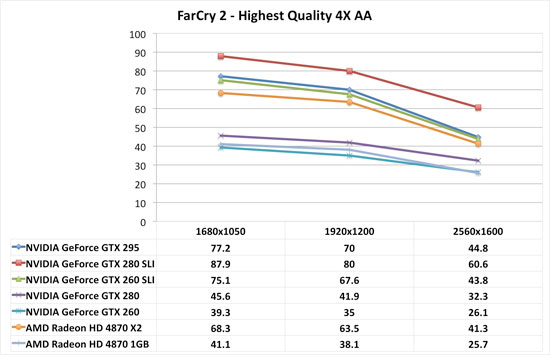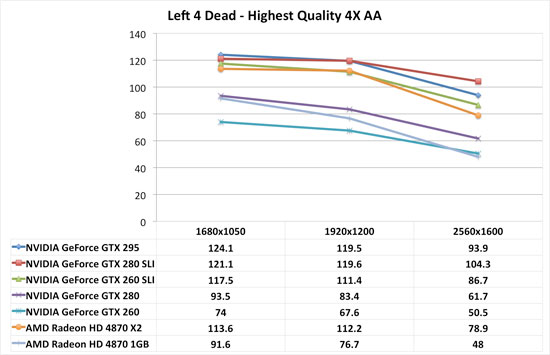
Original Link: https://www.anandtech.com/show/2708
NVIDIA GeForce GTX 295: Leading the Pack
by Derek Wilson on January 12, 2009 5:15 PM EST- Posted in
- GPUs
Now that we have some hardware in our hands and NVIDIA has formally launched the GeForce GTX 295, we are very interested in putting it to the test. NVIDIA's bid to reclaim the halo is quite an interesting one. If you'll remember from our earlier article on the hardware, the GTX 295 is a dual GPU card that features two chips that combine aspects of the GTX 280 and the GTX 260. The expectation should be that this card will fall between GTX 280 SLI and GTX 260 core 216 SLI.
As for the GTX 295, the GPUs have the TPCs (shader hardware) of the GTX 280 with the memory and pixel power of the GTX 260. This hybrid design gives it lots of shader horsepower with less RAM and raw pixel pushing capability than GTX 280 SLI. This baby should perform better than GTX 260 SLI and slower than GTX 280 SLI. Here are the specs:
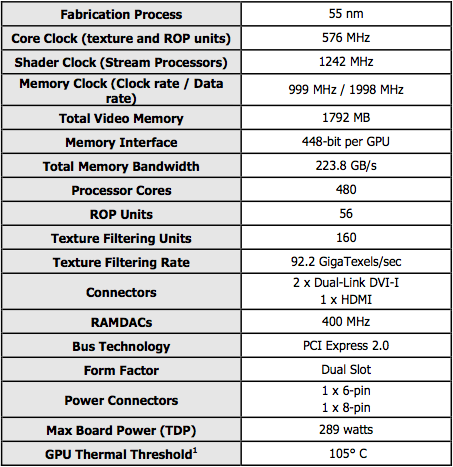
Our card looks the same as the one in the images provided by NVIDIA that we posted in December. It's notable that the GPUs are built at 55nm and are clocked at the speed of a GTX 260 despite having the shader power of the GTX 280 (x2).
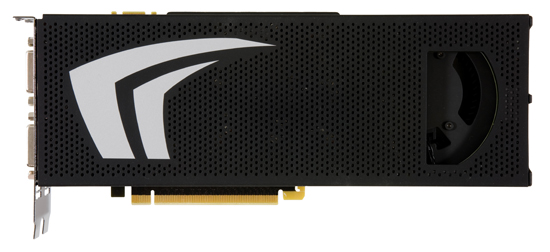
We've also got another part coming down the pipe from NVIDIA. The GeForce GTX 285 is a 55nm part that amounts to an overclocked GTX 280. Although we don't have any in house yet, this new card was announced on the 8th and will be available for purchase on the 15th of January 2009.
There isn't much to say on the GeForce GTX 285: it is an overclocked 55nm GTX 280. The clock speeds compare as follows:
| Core Clock Speed (MHz) | Shader Clock Speed (MHz) | Memory Data Rate (MHz) | |
| GTX 280 | 602 | 1296 | 2214 |
| GTX 285 | 648 | 1476 | 2484 |
We don't have performance data for the GTX 285 yet, but expect it (like the GTX 280 and GTX 295) to be necessary only with very large displays.
| GTX 295 | GTX 285 | GTX 280 | GTX 260 Core 216 | GTX 260 | 9800 GTX+ | |
| Stream Processors | 2 x 240 | 240 | 240 | 216 | 192 | 128 |
| Texture Address / Filtering | 2 x 80 / 80 | 80 / 80 | 80 / 80 | 72/72 | 64 / 64 | 64 / 64 |
| ROPs | 28 | 32 | 32 | 28 | 28 | 16 |
| Core Clock | 576MHz | 648MHz | 602MHz | 576MHz | 576MHz | 738MHz |
| Shader Clock | 1242MHz | 1476MHz | 1296MHz | 1242MHz | 1242MHz | 1836MHz |
| Memory Clock | 999MHz | 1242MHz | 1107MHz | 999MHz | 999MHz | 1100MHz |
| Memory Bus Width | 2 x 448-bit | 512-bit | 512-bit | 448-bit | 448-bit | 256-bit |
| Frame Buffer | 2 x 896MB | 1GB | 1GB | 896MB | 896MB | 512MB |
| Transistor Count | 2 x 1.4B | 1.4B | 1.4B | 1.4B | 1.4B | 754M |
| Manufacturing Process | TSMC 55nm | TSMC 55nm | TSMC 65nm | TSMC 65nm | TSMC 65nm | TSMC 55nm |
| Price Point | $500 | $??? | $350 - $400 | $250 - $300 | $250 - $300 | $150 - 200 |
For this article will focus heavily on the performance of the GeForce GTX 295, as we've already covered the basic architecture and specifications. We will recap them and cover the card itself on the next page, but for more detail see our initial article on the subject.
The Test
| Test Setup | |
| CPU | Intel Core i7-965 3.2GHz |
| Motherboard | ASUS Rampage II Extreme X58 |
| Video Cards | ATI Radeon HD 4870 X2 ATI Radeon HD 4870 1GB NVIDIA GeForce GTX 295 NVIDIA GeForce GTX 280 SLI NVIDIA GeForce GTX 260 SLI NVIDIA GeForce GTX 280 NVIDIA GeForce GTX 260 |
| Video Drivers | Catalyst 8.12 hotfix ForceWare 181.20 |
| Hard Drive | Intel X25-M 80GB SSD |
| RAM | 6 x 1GB DDR3-1066 7-7-7-20 |
| Operating System | Windows Vista Ultimate 64-bit SP1 |
| PSU | PC Power & Cooling Turbo Cool 1200W |
Age of Conan Performance
We've added a bunch of new tests this time around, but we decided to keep a few games around. Age of Conan is one of these, and it's one of the games we've consistently tested that favors AMD hardware. As we can see not much has changed this time around either. The none of the NVIDIA hardware can keep up with the AMD Radeon HD 4870 X2 in this test. As for NVIDIA versus NVIDIA, the GeForce GTX 295 splits the difference between the GTX 260 SLI and GTX 280 SLI setups.
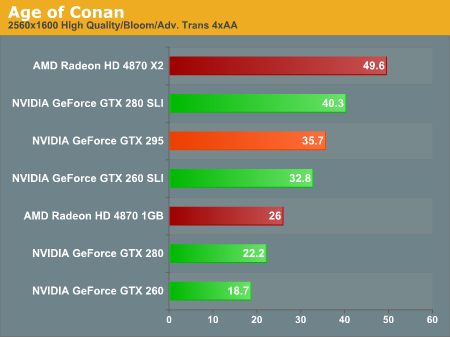
With this game, at 2560x1600 and our quality settings (not even the highest possible), a multi-GPU solution is required for higher than 30fps gameplay. The nature of the game makes it playable at slightly lower framerates, but the safe bet is on lowering settings or getting more than one GPU. We don't expect that the GTX 285 will be able to keep up with the Radeon HD 4870 1GB either.
We're also still waiting for the DirectX 10 version of the game to come out, and we will transition to that version when we are able.
Call of Duty World at War Performance
Hooray, another WWII game. We don't have enough of those. This one is the next offering in the Call of Duty series, and we've just added it to our test suite. we test in the first level running a straight line through a forested area.
The NVIDIA GeForce GTX 295 performs over 25% better than the Radeon HD 4870 X2 in this test. The GTX 260 leads the HD 4870 and the GTX 260 SLI also leads the 4870 X2 here. This game definitely favors NVIDIA hardware.
Crysis Warhead Performance
This game is another killer at 2560x1600. Only multi-GPU solutions will cut it at this resolution with Gamer settings and Enthusiast shaders enabled. Once (if) the 64-bit patch is released, we should see some general performance improvement as well, but graphics limitations are the name of the game here. Crysis was tough on PCs, and while Warhead is a bit more optimized, this one is still a system killer.

With a 30" display, a minimum of a GTX 295 is required for playability with the settings we chose. Of course, dropping the settings down a bit will certainly help out, but even on smaller panel sizes a high end single card will be desireable for the highest image quality settings. Luckily for fans, running in DX9 mode with slightly lower settings is very playable and not that much of a sacrifice.
Crysis Warhead seems to favor SLI over CrossFire as the single 4870 1GB leads the GTX 260 while the GTX 260 SLI wins out over the 4870 X2. This isn't so much a question of what architecture handles the game better as what multi-GPU solution handles the game better. Either way, it comes out in NVIDIA's favor.
Fallout 3 Performance
Fallout 3 is based on the Gamebryo engine that powered Oblivion, though it has gone through modifications and tweaks along the way. The game looks great with all the settings cranked and it's pretty fun as well. We disabled vsync and set iPresentInterval to zero, but we still had some quirks with framerate. It seems like we may be system limited in some ways, which is impressive given our system. In the future we will try to refine our test to make it more graphically intense though some .ini file tweaks and see if that helps out.

Framerates are compressed up near the 77 frames per second. The lead the NVIDIA hardware has here is thus also compressed. In running around, it is clear framerate is not limited: we saw max FPS up over 110, but the benchmark we ran just ends up coming out this way. This is a straight line outdoor run at twilight.
Again, the single Radeon HD 4870 1GB leads the GTX 260, but GTX 260 SLI outperforms the 4870 X2 indicating an SLI advantage over CrossFire (or an NVIDIA driver advantage over AMD -- without more low level technical data we can't assess what exactly the issue is). But as this article focuses on the GTX 295, even though the gap looks small we can say that this one goes to NVIDIA as well.
FarCry 2 Performance
As we saw in our FarCry 2 performance testing last year, depending on the test we run it's really a wash between NVIDIA and AMD single cards, but for this one it looks like SLI holds a bit of an advantage.
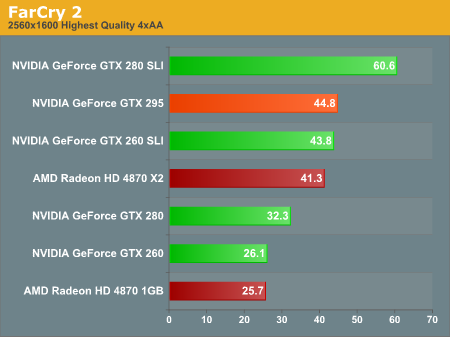
It comes out close, but the GTX 295 takes the lead. Here it appears that the GTX 295 is limited either by memory bandwidth or the number of ROPs, as the GTX 295 performs nearer to GTX 260 SLI than to GTX 280 SLI.
Left 4 Dead Performance
Left 4 Dead is a Source engine based zombie game a la 28 days later.
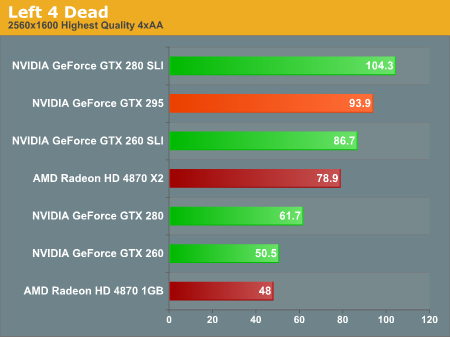
Once again, single card 4870 keeps up with the GTX 260 but GTX 260 SLI and the GTX 295 easily lead the 4870 X2. It looks like AMD's weak point isn't necessarily in their architecture but in their ability to successfully make CrossFire a real competitor to SLI.
Race Driver GRID Performance
Bookending our tests are the two games that show the AMD solution as still competitive depending on the test we run. GRID has and still shows solid single and dual GPU performance on AMD solutions.
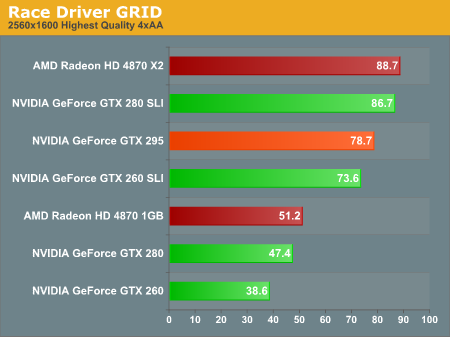
Even though many of our test today showed the GTX 295 leading the Radeon HD 4870 X2 while the 4870 1GB remained competitive with the single GTX 260, GRID and Age of Conan both show that it all comes down to the engine. The 4870 X2 leads even the GTX 280 SLI.
Final Words
We'll start with NVIDIA vs. NVIDIA and move on from there. The GeForce GTX 295 performed pretty much where we expected: between the GTX 260 SLI and the GTX 280 SLI setups. In some games, the GTX 295 performed very nearly at GTX 260 performance, indicating a bottleneck somewhere in memory bandwidth or with the ROPs. Because the clock speeds and hardware widths are the same, on GTX 295 and 260 SLI games limited by memory performance or ROP performance will run fairly similarly. In cases where shader performance was more important we saw more separation, but the clock speed, memory bandwidth and ROP advantage of the GTX 280 SLI system consistently outpaced the GTX 295 by a good margin.
When it comes to how the GTX 295 stacks up against NVIDIA's current line up, it's closer to a single card GTX 260 SLI than anything else. Putting two GTX 260 core 216 cards in SLI will get a little closer, but since the 295 will still have an advantage in shader power we can't expect the gap to disappear. Those who already have a GTX 260 or two will not really be interested in the GTX 295 as an upgrade option, as GTX 260 SLI is very much close enough to GTX 295 performance.
Comparing NVIDIA to AMD, it's clear that NVIDIA has recaptured the halo product at least in the majority of tests we ran in this snapshot of performance. We are noticing a trend that has some games heavily favoring one architecture or another, which makes general recommendations harder than usual. But the advantage this time around is certainly with NVIDIA. The Radeon HD 4870 1GB still hangs on competitively, but SLI wins out over CrossFire.
Though we are using the 8.12 hotfix that improves game performance and (as far as we've noticed) stability on Intel Core i7 systems, we can't be sure when this hotfix will make it into a WHQL driver. We've spent a good deal of time being hard on AMD for their driver support lately. As we've said since the launch of the R700, the success or failure of AMD's new direction for their highest end parts depends entirely on the ability of their driver team to make sure the experience and performance are top notch on single-card dual-GPU platforms. This includes having support in at least beta driver as the launch of new games and having high quality support for all new hardware platforms released. It is also imperative that all fixes in any beta or hotfix driver make it into the very next WHQL driver.
NVIDIA has the advantage on the highest end single card product, but we don't see this as a boon for anyone but people running 30" displays at this point. There really is just no reason to drop the cash on a GTX 295 unless you're looking at 2560x1600 gaming. For smaller displays, cheaper parts will work great. It's still hard to recommend buying for longevity because of the way performance can fall heavily in favor of AMD or heavily in favor of NVIDIA depending on the game. We just can't know until we get there which solution will be better on future titles.
While NVIDIA has the halo, AMD's top of the line card is slightly cheaper than the GTX 295 and still outperforms it in some cases. Currently the Radeon HD 4870 X2 is a $450 card while the GeForce GTX 295 is a $500 part. This 11% price advantage (10% savings depending on how you look at it) might be incentive for some people. We don't consider it enough to recommend the Radeon HD 4870 X2 over the GTX 295 though. There are some opportunities with mail in rebates that could net you a 4870 X2 for closer to $400, but mail in rebates are always hit or miss, aren't permanent and not everyone likes them. If the 4870 X2 were being sold without a rebate for $400, the choice would be more difficult, but as it stands, the GTX 295 gets the nod even considering price from us. If you need a top of the line single card option that is.
The highest performing soluiton we tested is still the GeForce GTX 280 SLI setup. And when the GTX 285 makes its way out, GTX 285 SLI will very likely take that crown. We do have yet to test quad performance as we only have one card. We suspect scaling similar to past experience with quad (meaning between 2x and 3x performance rather than a linear increaes), but we will certainly bring you an update as soon as we are able.
Now what we really need are some midrange GT200 based parts.

